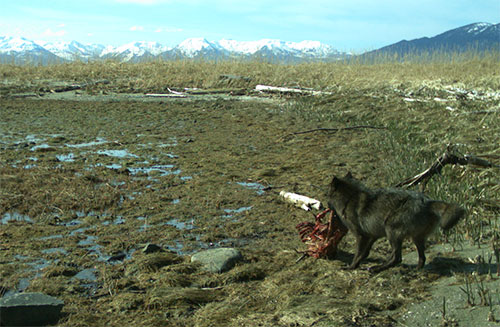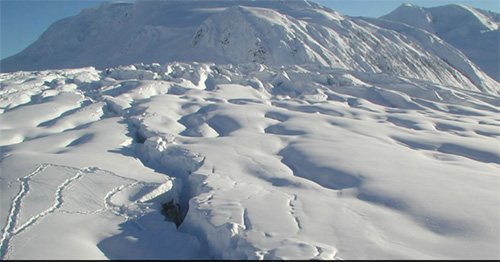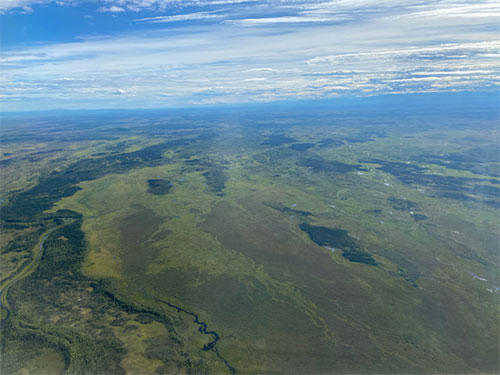










 Contact Contact 
 Webmail
Letters Webmail
Letters
 News Tips News Tips
 Copyright Info Copyright Info
 Archives Archives
Quick News
Search
 Alaska Alaska
 Ketchikan Ketchikan
 SE Alaska SE Alaska
Columns
- Articles
 Dave Kiffer Dave Kiffer
 Money Matters Money Matters
Historical
Ketchikan
 June Allen June Allen
 Dave
Kiffer Dave
Kiffer
 Louise
B. Harrington Louise
B. Harrington
Sports
 Ketchikan Links Ketchikan Links
Public Records
 FAA Accident Reports FAA Accident Reports
 NTSB
Accident Reports NTSB
Accident Reports
 Court Calendar Court Calendar
 Recent Filings & Case Dispositions Recent Filings & Case Dispositions
 Court Records Search Court Records Search
 Sex Offender Reg. Sex Offender Reg.
 Public Notices Public Notices
 Alaska Recall Alerts Alaska Recall Alerts
 Recalls.gov Recalls.gov
 AST Daily Dispatch AST Daily Dispatch
 KTN
Police Reports KTN
Police Reports
 Juneau Police Reports Juneau Police Reports
Weather,
Webcams
 Today's
Forecast Today's
Forecast
 KTN
Weather Data KTN
Weather Data
 AK
Weather Map AK
Weather Map
 AK Weathercams AK Weathercams
 AK Earthquakes AK Earthquakes

|

Monday
February 06, 2023
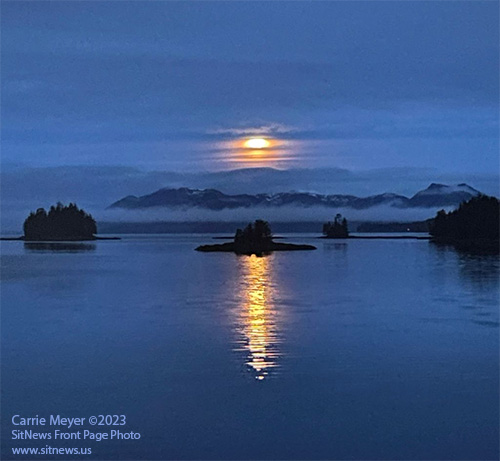
Tongass Sunrise
Friday - February 03, 2023
SitNews Front Page Photo By CARRIE MEYER©2023
To have your photo(s) featured on the front page,
email your photo(s) to editor@sitnews.us |
|
SE Historical: Remembering Hyder; Hyder, British Columbia, that is! By DAVE KIFFER - Everyone knows about the twin towns at the head of Portland Canal, Hyder, Alaska and Stewart, British Columbia.
They grew out of mining activity on both sides of the border and have experienced boom and bust, and more boom and bust, for more than a century.
But what is often forgotten is that there was a third small town at the head of Portland Canal; Hyder, BC.
On maps of the 1920s, there are two Hyders, one on each side of the border. It is not a misprint. There really was a Hyder, British Columbia, in those days.
"Hyder, BC was built adjacent to Hyder, Alaska in the early 1920s in response to the success of the Premier Mine," Longtime Portland Canal resident Ian McLeod wrote in 2004 in his book"Prospectors, Promoters and Hard Rock Miners: Tales of the Stewart, BC and Hyder, Alaska Camps." "With Stewart just two miles north and the wharf right beside them, the two Hyders had access to hundreds of miners coming and going."
Both Hyders were built on pilings that stretched more than 100 yards from the heavily timbered shoreline out into the mudflats of the Salmon River. Hyder, Alaska was much larger in those days with more than 40 buildings and 500-750 residents. Hyder, BC had about a dozen buildings on its pillings and a population of about 75 people. The border between the towns, and the countries, was a narrow road between the buildings. To ships approaching from the water, it appeared as a single town.
" (Hyder, BC) consisted of...several hotels, a restaurant, the Canadian Customs, two whore houses and three or four 'blind pigs,' " McLeod wrote, using the colloquial term for unlicensed bars. - More...
Monday - February 06, 2023
Ketchikan: Alex Kramarczuk Appointed Ketchikan District Attorney - Assistant District Attorney Alex Kramarczuk was appointed Ketchikan District Attorney recently. Kramarczuk has served the community of Ketchikan as an Assistant District Attorney since 2018, prosecuting a variety of cases, including sexual assaults and homicides.
Former Ketchikan District Attorney Kristian Pickrell was appointed to the bench in Ketchikan District Court last October.
“I’m confident that Alex will serve Ketchikan and the southern communities in Southeast Alaska with the same commitment and leadership he has demonstrated throughout his career with the Department of Law,” said Alaska Attorney General Treg Taylor.
Kramarczuk, over the last several years, has helped foster productive and professional relationships with law enforcement and criminal justice partners, building upon the legacy left by prior Ketchikan District Attorneys of civility and professionalism. Kramarczuk has demonstrated outstanding leadership skills over the last two months while the position has been vacant.
Prior to joining the Criminal Division at the Alaska Department of Law, Alex worked as a law clerk for former Alaska Superior Court Judge Louis Menendez and as an intern with the Department of Law’s Torts and Workers’ Compensation section. Kramarczuk invests in his community, serving on the Ketchikan Youth Court and Ketchikan Museum Advisory Boards. - More..
Monday - February 06, 2023
Alaska: Governor Introduces Postpartum Medicaid Expansion, Adult Home Care Bills - Friday, Governor Mike Dunleavy introduced three bills which are components of Alaska’s Healthy Families Initiative. HB 59 would allow the extension of postpartum Medicaid coverage from the required 60 days to 12 months. HB 58 would establish an adult home care service. The third bill introduced is related to the implementation of EO 121 which separated the Department of Health and Social Services into the Department of Health (DOH) and the Department of Family and Community Services (DFCS).
“As I said my State of the State address, my vision is for Alaska to be the best place in the country for families,” said Governor Mike Dunleavy. “These bills aren’t conceptual. They will tangibly improve quality of life for thousands of Alaskans and help make sure that bureaucratic barriers don’t get in the way of Alaskan families.”
HB 59 authorizes the Department of Health to implement section 9812 of the American Rescue Plan Act, which allows but does not require the extension of postpartum coverage from the required 60 days to 12 months for eligible beneficiaries. Extending postpartum Medicaid to 12 months is one evidence-based action the department can take to support growing families in Alaska.
Maternal mental health is one of Alaska’s most significant contributing factors to pregnancy-associated deaths. Many women who experience postpartum depression don’t have an onset of symptoms until after that initial screening, which is too late to seek treatment with Medicaid coverage. Nearly 16 percent of women in Alaska who experienced perinatal depression or anxiety between 2015 and 2020 indicated that they could not access needed treatments or support due to challenges with insurance or cost. Expanding postpartum Medicaid coverage will ensure that mothers are able to receive the physical and mental health care needed support a strong start to their child’s life.
In addition to mental health, other areas of impact include improved access to care in the following critical areas: substance use, family planning, and prevention and screening of chronic diseases. By extending postpartum coverage through the critical year post-delivery, this bill reduces gaps in care. Gaps in care are associated with increased use of the emergency room and poorer health outcomes. With extended postpartum coverage, women are much more likely to have access to continuous, regular primary care that is less costly than emergency services. - More...
Monday - February 06, 2023
|
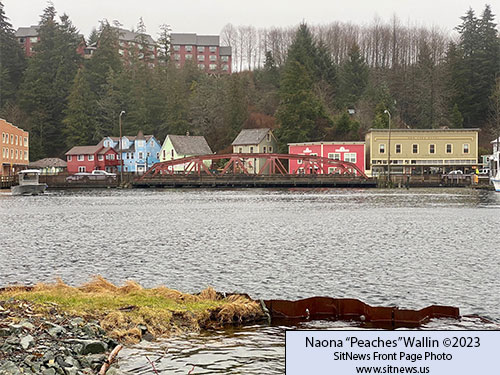
High Tide
A 19.2 high tide on January 22, 2023
SitNews Front Page Photo By NAONA "Peaches" WALLIN©2023
https://www.peachespics.com
To have your photo(s) featured on the front page,
email your photo(s) to editor@sitnews.us |
|
Alaska: Alaska Department of Public Safety Releases Draft Body Camera Policy; Pilot Program Deployment of Body Cameras Planned for Spring 2023 - The Alaska Department of Public Safety has released a draft copy of their body worn camera policy for public feedback. The new policy will govern the use of body worn cameras, personal audio recorders, and dash cameras under the title of mobile audio and video recording (MAVR). In July 2022, the Alaska Department of Public Safety was awarded $3.58 million in state funding and $938,000 in federal funding for the project.
The DPS draft body worn camera policy is based off of national best practices from the International Association of Chiefs of Police, US Department of Justice, and other similarly situated law enforcement agencies across the nation.
The official public comment period will run from February 8, 2023 – March 1, 2023.
Highlights from the draft DPS policy:
• DPS may proactively release MAVR recordings after officer-involved-shootings and other critical incidents once the primary interviews are completed with suspects, witnesses, and victims.
• DPS will retain MAVR evidence that is captured for between 26 months and or 99 years depending on the nature of the interaction that is recorded.
• Members of the public will be able to request copies of MAVR recordings after an investigation is completed and any related court proceedings involving the state have been closed under the Alaska Public Records Act.
• Describes when officers should activate a MAVR device to record evidence.
“The Alaska Department of Public Safety has been working for years to bring body worn cameras to our department and the citizens that we protect. Not only do body worn cameras increase transparency and trust, but they help better serve the Alaskans that we interact with every day, and provide undeniable video evidence for prosecutions and investigations,” said Alaska Department of Public Safety Commissioner James Cockrell. “I hope that Alaskans will take a look at our draft policy and give us candid feedback and ways that can make body cameras better for all Alaskans." - More...
Monday - February 06, 2023 |
|
Southeast Alaska: Wolves eliminate deer on Alaskan Island then quickly shift to eating sea otters, research finds - Wolves on an Alaskan island caused a deer population to plumet and switched to primarily eating sea otters in just a few years, a finding scientists at Oregon State University and the Alaska Department of Fish and Game believe is the first case of sea otters becoming the primary food source for a land-based predator. Using methods such as tracking the wolves with GPS collars and analyzing their scat, the researchers found that in 2015 deer were the primary food of the wolves, representing 75% of their diet, while sea otters comprised 25%. By 2017, wolves transitioned to primarily consuming sea otters (57% of their diet) while the frequency of deer declined to 7%. That pattern held through 2020, the end of the study period.
“Sea otters are this famous predator in the near-shore ecosystem and wolves are one of the most famous apex predators in terrestrial systems,” said Taal Levi, an associate professor at Oregon State. “So, it’s pretty surprising that sea otters have become the most important resource feeding wolves. You have top predators feeding on a top predator.”
The finding were published recently in PNAS.
Historically, wolves and sea otters likely lived in the study area, Pleasant Island, which is located in an island landscape adjacent to Glacier Bay about 40 miles west of Juneau. The island is about 20 square miles, uninhabited and accessible only by boat or float plane.
During the 1800s and much of the 1900s, populations of sea otters in this region were wiped out from fur trade hunting. Unlike wolves in the continental USA, Southeast Alaskan wolves were not hunted to local extinction. Only in recent decades, particularly with the reintroduction and legal protection of sea otters, have the populations of both species recovered and once again overlapped, providing new opportunities for predator-prey interactions between the two species.
The researchers studied the wolf pack on Pleasant Island and the adjacent mainland from 2015 to 2021. Gretchen Roffler, a wildlife research biologist with the Alaska Department of Fish and Game, and others from the department collected 689 wolf scats, many along the island’s shoreline.
Once the scat is collected, members of Levi’s lab in Oregon used molecular tools, such as DNA metabarcoding and genotyping of the scat, to identify individual wolves and determine their diets. - More...
Monday - February 06, 2023
|
|
Alaska: Researchers uncover secrets on how Alaska’s Denali Fault formed - When the rigid plates that make up the Earth’s lithosphere brush against one another, they often form visible boundaries, known as faults, on the planet’s surface. Strike-slip faults, such as the San Andreas Fault in California or the Denali Fault in Alaska, are among the most well-known and capable of seriously powerful seismic activity. Studying these faults can help geoscientists not only better understand the process of plate tectonics, which helped form the planet’s continents and mountains, but also better model their earthquake hazards. The problem is that most studies on these types of faults are (quite literally) shallow, looking only at the upper layer of the Earth’s crust where the faults form.
New research led by Brown University seismologists digs deeper into the Earth, analyzing how the part of the fault that’s near the surface connects to the base of the tectonic plate in the mantle. The scientists found that changes in how thick the plate is and how strong it is deep into the Earth play a key role in the location of Alaska’s Denali Fault, one of the world’s major strike-slip faults.
The findings begin to fill major gaps in understanding about how geological faults behave and appear as they deepen, and they could eventually help lead future researchers to develop better earthquake models on strike-slip faults, regions with frequent and major earthquakes.
“That means when geoscientists model earthquake cycles, they’ll have new information on the strength of the deeper rocks that would be useful for understanding the dynamics of these faults, how stress will build up on them, and how they might rupture in the future,” said Karen M. Fischer, a study author and geophysics professor at Brown.
The study, published in December in Geophysical Research Letters, was led by Brown alumna Isabella Gama, who completed the work last year while she was a Ph.D. student in the University’s Department of Earth, Environmental and Planetary Sciences. The paper focuses primarily on the Denali Fault, a 1,200-mile-long fault that arcs across most of Alaska and some of Western Canada. In 2002, it was the site of a magnitude 7.9 earthquake that sloshed lakes as far away as Seattle, Texas and New Orleans.
The researchers used new data from a cutting-edge network of seismic stations to create a new 3D model of seismic wave velocities throughout Alaska. With this innovative tool, the researchers discovered changes in the thickness and internal strength of the tectonic plate that Alaska sits on. The model shows how these changes in plate strength, that extend as deeply as about 80 kilometers, feed back into the mechanics of where the Denali fault line is produced. - More...
Monday - February 06, 2023 |
|
Alaska: NASA fieldwork studies signs of climate change in Arctic, Boreal regions - From the window of a NASA Gulfstream III research aircraft summer of 2022, Alaska looks like a pristine wilderness untouched by humans. The land is covered in lush, green vegetation and dotted with bright blue lakes. Snow-capped mountains reach toward the sky, and chocolate milk-colored rivers snake across the landscape. The obvious signs of human activity – cities, roads, infrastructure – are hard to spot. But on closer inspection, some hints of human-induced change appear to the eye. Sunken pockets of land. Abnormally tilted trees. Ponds where there used to be dry ground. Through the eyes of scientists collecting data from the ground and the air, the signal is clear: The Arctic is being affected by climate change more than most places on Earth. Since 2015, scientists participating in NASA’s Arctic Boreal Vulnerability Experiment (ABoVE) have been studying the impacts of climate change on Earth’s far northern regions and how those changes are intertwined.
“ABoVE is a large-scale study of environmental change, not just climate change,” said Peter Griffith, a carbon cycle researcher at NASA’s Goddard Space Flight Center in Greenbelt, Maryland, and one of the leaders of ABoVE. “And we’re doing this as only NASA can: by studying this region from leaf to orbit.”
Previous field and airborne campaigns focused on things like changes in plant cover and shifting animal migration patterns. In the summer of 2022, the team investigated permafrost thaw, methane emissions from lakes, and the effects of wildfires in Alaska and northwestern Canada. They did this with instruments observing from research aircraft and with scientists collecting measurements on the ground.
Studying Arctic Changes from Air and Space
One of the key components of ABoVE is the airborne campaign, which uses research aircraft like the NASA Gulfstream III airplane. This year the plane was mounted with the Uninhabited Aerial Vehicle Synthetic Aperture Radar, or UAVSAR, which sends out pulses of radio waves that reflect off of Earth's surface and give scientists an accurate idea of the shape of the land and water surfaces below – even when looking through clouds or thick vegetation.
Each year members of the ABoVE team fly over their field sites, as well as wildfire burn scars and other areas of scientific interest, allowing them to compare measurements taken from both the air and ground. They also revisit sites from year to year to see how the landscapes evolve over time.
UAVSAR is similar to the main instrument on an upcoming satellite. The NASA-ISRO (NISAR) satellite will be a joint mission between the Indian Space Research Organization and NASA to observe Earth’s land and ice. NISAR is also part of NASA’s upcoming Earth System Observatory.
“ABoVE and UAVSAR give the research community a really good example of what NISAR data will look like and what kind of science they can extract from these datasets,” explained Franz Meyer, a NISAR science team member who also is the chief scientist of the Alaska Satellite Facility in Fairbanks. - More...
Monday - February 06, 2023
|
MICHAEL REAGAN: THE IRS TIGHTENS THE SCREWS ON THE GIG ECONOMY - The IRS is so kind.
Our most beloved federal agency has delayed until next year a new income-reporting law it has carefully designed to squeeze the last drops of tax revenue out of many of us.
The new IRS rule is aimed at millions of self-employed people and small business people who sell goods or services on places like eBay, drive part-time for Uber or earn income through social media companies like Airbnb.
Right now, the requirement for having to report this kind of side-hustle income to the taxman are transactions where payments exceed $20,000, or more than 200 transactions per year.
But starting in the 2024 tax year, the IRS will tighten the screws on the little guys that make the gig economy go. - More...
Monday - February 06, 2023
PETER ROFF: FORWARD PROGRESS ON CRIMINAL JUSTICE REFORM HAS STALLED OUT - There are lot of things that have come out of Washington over the past few years that have done more harm than good.
Partisan divisions have hardened to the point it’s almost impossible to reach across the aisle. One place progress had been made, happily, was in reforming the criminal justice system. Unfortunately, some people decided reform also meant the implementation of policies like “no cash” bail in places like Manhattan and Los Angeles, which keep bad people on the streets committing additional crimes instead of behind bars where they belong.
As a result, the reform movement has ground to a halt, even as there’s much real work still to be done. From the 1980s onward, national figures like then-Sen. Joe Biden, onetime chairman of the Senate Judiciary and principal author of the 1994 Crime Bill, decided minor crimes should be subject to major penalties. He and people like him who wanted to be president decided they needed to prove they were “tough on crime.” As a result, too many people went to prison for too long.
That doesn’t change because criminals who should be “sent away” now aren’t. We can make our communities safer without abandoning the drive for reform that began more than a decade ago out of a bipartisan desire to see old wrongs righted. - More..
Monday - February 06, 2023
FINANCIAL FOCUS: Can you reduce the Medicare surcharge? Provided By BEN EDWARDS, AAMS® - Before you turn 65, you’ll want to become familiar with Medicare’s rules and features. And if you’re a high earner, you’ll want to be especially aware of the Medicare premium surcharge — because, over time, it can add up to some significant dollars.
The premium surcharge — known as the income related monthly adjustment amount, or IRMAA — is assessed on premiums for Medicare Parts B and D, and generally is based on an individual’s modified adjusted gross income (MAGI) of two years ago. So, the IRMAA for 2023 would be based on one’s MAGI from 2021.
For someone who’s married and files taxes jointly, and whose MAGI for 2021 was $194,000 or less, the Part B premium for 2023 will be $164.90 per month, and the Part D premium will be whatever amount is charged by their Medicare plan. But if their 2021 MAGI was between $194,000 and $246,000, they’ll pay $230.80 (a surcharge of $65.90) for Part B and an additional $12.20 for Part D. And the IRMAA rises at different income levels, reaching a maximum of $560.50 (a surcharge of $395.60) for Part B and an additional $76.40 for Part D for a MAGI of $750,000 or more. - More...
Monday - February 06, 2023
|
POLITICAL CARTOONS

Political Cartoon: 2023 State of the Union
Tuesday - February 07, 2023 - 5:00 PM Alaska Time
by Rivers©2023, CagleCartoons.com
Distributed to subscribers for publication by CagleCartoons.com

Political Cartoon: Chinese Surveillance
by John Darkow©2023, Columbia Missourian
Distributed to subscribers for publication by CagleCartoons.com

Political Cartoon: National Debt
by Dick Wright©2023, PoliticalCartoons.com
Distributed to subscribers for publication by CagleCartoons.com

Political Cartoon: KJP Refers To Counsel
by Gary McCoy©2023, Shiloh, IL
Distributed to subscribers for publication by CagleCartoons.com

Political Cartoon: Big Oil Profit Wallowing
by Monte Wolverton©2023, Battle Ground, WA
Distributed to subscribers for publication by CagleCartoons.com |
Big wins for Ketchikan By U.S. Senator Lisa Murkowski Earlier [in January], the 117th Congress formally adjourned, marking the close of a remarkably productive legislative stretch for Alaska. The last Congress was one of the best for our state in recent memory, and the bipartisan bills we passed during it will produce lasting benefits for Ketchikan.
Most significant is the Infrastructure Investment and Jobs Act, which I played a lead role on. In just over a year, roughly $3 billion from it has been announced for Alaska. Those dollars are helping us build, expand, and modernize everything from roads, bridges, ports, and airports to our water, broadband, energy, and ferry systems. In doing so, they’re creating jobs, boosting our economy, and transforming lives.
The bipartisan infrastructure law includes investments to deploy fiber broadband on Prince of Wales Island and in Metlakatla, along with substantial support that should go to the Marine Highway System to help reconnect Ketchikan and Southeast Alaskans. The recent announcement of $285 million for the Alaska Marine Highway System will allow us to upgrade docks in five communities, modernize several vessels including the Tazlina and Kennicott, and design a new mainliner.
In addition to the infrastructure bill, the budget packages we passed included hundreds of millions of dollars in standard allocations for Alaska. We also leveraged my position as a senior appropriator to directly fund nearly 200 critical projects across the state without adding to overall spending levels.
Leaders in Ketchikan and across the region shared their priorities with me—and now, funding is going to the Ketchikan Gateway Borough and Craig to upgrade their wastewater treatment plants. We also secured the funds needed to repair the crumbling Schoenbar Culvert, for airport upgrades, to deploy electric buses, and for a new CT scanner at the PeaceHealth Medical Center.
Over the past two years, we likewise prioritized improving the quality of life for our servicemembers, and supported and modernized the Coast Guard through the Don Young Coast Guard Reauthorization Act. The bipartisan infrastructure law provided further investments for the Coast Guard - including a 65-ton crane for the Ketchikan industrial facility. - More...
Monday - February 06, 2023
 |
THE WELFARE QUEENIES OF KETCHIKAN By David G Hanger - The Paycheck Protection Program was established in late March 2020 with an initial allocation of $394 billion to provide forgivable loans to small businesses to pay their employees for the first two-and-a-months of the Covid pandemic. Thereafter, the program was extended multiple times over a period of about 15 months for a total allocation of right at $1 trillion. The maximum for any job covered was supposed to be limited to $100,000. Yet despite that the program’s average cost ranged from $168,000 to $258,000 per job, and it has been duly noted both by academics and others that any number of government programs would have provided these benefits at a much lower cost, for example the increased use of unemployment insurance.
Thus “the majority of the benefits (of the PPP program) flowed to business owners, their creditors and their suppliers rather than to workers.” Only “23% to 34% of the dollars” went to workers with “three-fourths (of $1 trillion) accruing to the top quintile of households.”
Independent research conducted at the University of Texas at Austin determined that at least 15% of all PPP loans were fraudulent. The Federal government estimates as high as one-third, and in large measure because of this recognition has extended the statute of limitation for PPP fraud to 10 years from the standard three. Some of you are going to be spending a long time looking over your shoulder, and the interest is accruing for every day of that time.
The crassness and the corruption begin with the Small Business Administration (SBA) and the Trump cronies assigned to administer this program. According to the General Accountability Office (GAO), “The report found that the PPP loan application process allowed small businesses to self-certify their needs and qualification. Consequently, some applicants were able to exploit the program by illegitimately inflating their payroll costs to qualify for larger PPP loans, misrepresenting their number of employees to illegitimately appear eligible for a PPP loan, and certifying that the loan proceeds would be used for allowable costs while actually using the loan proceeds for personal use.” What essentially happened is this bunch of corrupt clowns rather than organizing and administering a program chose to open the floodgates to corruption with an inside twist, only starting with certain lenders being paid by SBA to rubber stamp these forgivable loans, most of which have already been forgiven, I should add.- More...
Monday - February 06, 2023
 |
Alaska Ferry System Cancellation of Prince Rupert Ferry Route Critique By Mary Lynne Dahl - The numerous problems facing our Alaska Marine Highway System (AMHS) are on the verge of causing this entire transportation system for Southeast Alaska to collapse. The primary reasons for this imminent collapse are budgetary, management and planning mistakes that have been tolerated and even promoted by state government for many years. The subject of this critique is to provide an overview of the problems of the Alaska Highway System in general but more specifically the extreme difficulties resulting from the elimination of regular service to the port of Prince Rupert, BC in particular. Let’s look at some historical facts to get perspective on these issues.- More...
Sunday - January 29, 2023
Email your opinions and letters for publication to editor@sitnews.us
|
Articles &
photographs that appear in SitNews may be protected by copyright
and may not be reprinted or redistributed without written permission
from and payment of required fees to the proper sources.
E-mail your news &
photos to editor@sitnews.us
Photographers choosing to submit photographs for publication to SitNews are in doing so, granting their permission for publication and for archiving. SitNews does not sell photographs. All requests for purchasing a photograph will be emailed to the photographer.
|
|











|
|
![]() Contact
Contact ![]()
![]() Webmail
Letters
Webmail
Letters![]()
![]() News Tips
News Tips![]()
![]() Copyright Info
Copyright Info![]() Archives
Archives![]() Alaska
Alaska![]() Ketchikan
Ketchikan![]() SE Alaska
SE Alaska![]() Dave Kiffer
Dave Kiffer![]() Money Matters
Money Matters ![]() June Allen
June Allen![]() Dave
Kiffer
Dave
Kiffer![]() Louise
B. Harrington
Louise
B. Harrington ![]() Ketchikan Links
Ketchikan Links![]() FAA Accident Reports
FAA Accident Reports ![]() NTSB
Accident Reports
NTSB
Accident Reports![]() Court Calendar
Court Calendar![]() Recent Filings & Case Dispositions
Recent Filings & Case Dispositions ![]() Court Records Search
Court Records Search![]() Sex Offender Reg.
Sex Offender Reg.![]() Public Notices
Public Notices![]() Alaska Recall Alerts
Alaska Recall Alerts![]() Recalls.gov
Recalls.gov![]() AST Daily Dispatch
AST Daily Dispatch![]() KTN
Police Reports
KTN
Police Reports![]() Juneau Police Reports
Juneau Police Reports ![]() Today's
Forecast
Today's
Forecast![]() KTN
Weather Data
KTN
Weather Data![]() AK
Weather Map
AK
Weather Map![]() AK Weathercams
AK Weathercams![]() AK Earthquakes
AK Earthquakes
















